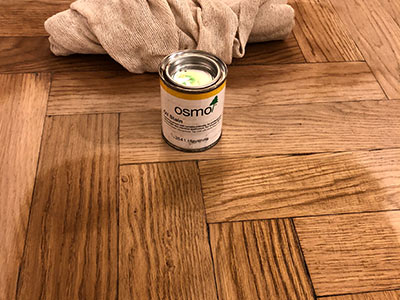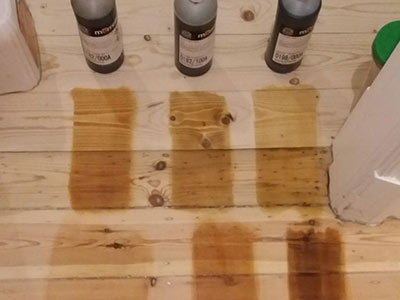Back to Flooring Products
Wood Floor Stain Application Explored
 Embarking on the journey of wood floor staining requires a mastery of expert techniques to achieve optimal results. In this article, we delve into the crucial aspects of surface preparation, application techniques, and considerations for different wood types. From the initial step of surface preparation, including thorough cleaning, precise wood floor sanding, and the removal of existing finishes or sealants, to the final touches of applying multiple coats for depth and richness, we guide you through each stage of the process.
Embarking on the journey of wood floor staining requires a mastery of expert techniques to achieve optimal results. In this article, we delve into the crucial aspects of surface preparation, application techniques, and considerations for different wood types. From the initial step of surface preparation, including thorough cleaning, precise wood floor sanding, and the removal of existing finishes or sealants, to the final touches of applying multiple coats for depth and richness, we guide you through each stage of the process.
Understanding the importance of expert techniques is paramount, as they not only ensure an even and smooth application but also contribute to the longevity and aesthetic appeal of the stained wood floor. Join us on this exploration of techniques that promise to elevate your wood floor staining endeavours, providing insights that are essential for achieving professional-looking and enduring results.
Surface Preparation
Surface preparation stands as the foundational cornerstone for achieving success in wood floor staining. As we embark on this journey, meticulous attention to detail is crucial. The initial steps involve thorough cleaning, ensuring a pristine wood surface free from debris, and precise sanding to create an even and smooth foundation. Additionally, the removal of existing finishes or sealants is paramount, allowing the new stain to penetrate the wood effectively. This phase lays the groundwork for an application that not only adheres evenly but also enhances the wood's natural beauty. From filling imperfections to guaranteeing a debris-free canvas, surface preparation sets the stage for a wood floor that not only showcases expert craftsmanship but also promises lasting and visually appealing results.
Application Techniques
Effective application techniques play a pivotal role in achieving a flawless and visually appealing result when staining a wooden floor. Brushing and rolling are common methods, providing even coverage and ensuring that the stain penetrates the wood grain uniformly. These techniques are particularly effective for larger floor areas. Cloth application, on the other hand, offers a more nuanced approach, allowing for customised finishes and greater control over the intensity of the colour. This method is well-suited for intricate or smaller sections where precision is essential. Before applying the stain, it is essential to test the colour on a small, inconspicuous area to ensure it aligns with the desired outcome. Following product instructions is equally crucial, as different stains may have specific application requirements and drying times. Adhering to these guidelines enhances the overall success of the staining process, resulting in a professionally finished wooden floor with the desired colour and texture.
Considerations for Different Wood Types
 When staining a wooden floor, considerations for different wood types are essential to achieve optimal results. Varying porosities among different wood species can impact how stains penetrate the material. Dense hardwoods, for instance, may resist stain absorption more than softer woods, leading to potential uneven colouration. It is crucial to understand the specific characteristics of the wood being treated to adjust the staining technique accordingly. Additionally, different wood types can react differently to stains, with some woods displaying more pronounced grain patterns and others absorbing stains more uniformly. Testing the stain on a small, inconspicuous area before applying it to the entire floor allows for a better understanding of how the specific wood type reacts to the chosen stain. This proactive approach enables adjustments in the application process, ensuring a harmonious and aesthetically pleasing finish that accentuates the natural beauty of the wood.
When staining a wooden floor, considerations for different wood types are essential to achieve optimal results. Varying porosities among different wood species can impact how stains penetrate the material. Dense hardwoods, for instance, may resist stain absorption more than softer woods, leading to potential uneven colouration. It is crucial to understand the specific characteristics of the wood being treated to adjust the staining technique accordingly. Additionally, different wood types can react differently to stains, with some woods displaying more pronounced grain patterns and others absorbing stains more uniformly. Testing the stain on a small, inconspicuous area before applying it to the entire floor allows for a better understanding of how the specific wood type reacts to the chosen stain. This proactive approach enables adjustments in the application process, ensuring a harmonious and aesthetically pleasing finish that accentuates the natural beauty of the wood.
Blotching and Uneven Absorption
Blotching and uneven absorption are common concerns when staining wooden floors, detracting from the desired finish and aesthetic appeal. Blotching occurs when the wood absorbs stain unevenly, resulting in dark patches that disrupt the overall appearance. Uneven absorption, on the other hand, leads to inconsistent colouration across the floor surface. To address these issues, employing proper stain application techniques becomes crucial. One effective method for controlling blotching is to use pre-conditioners or wood conditioners before applying the stain. These products help to regulate the absorption of the stain by sealing the wood pores, creating a more even surface. Additionally, sanding the wooden surface thoroughly and applying a wood conditioner can help minimise the impact of blotching. Furthermore, choosing the right type of stain, such as gel stains or pigment stains, can contribute to a more uniform colouration. Careful attention to preparation and application techniques is essential to achieve a beautifully stained wooden floor without the drawbacks of blotching and uneven absorption.
Layering for Depth and Richness
Layering for depth and richness is a key strategy when staining a wooden floor, enhancing the overall aesthetic and contributing to a professional-looking finish. The significance of applying multiple coats lies in the ability to build up the intensity of the stain, creating a nuanced and deep colouration that adds dimension to the wood. Each layer penetrates the grain, allowing the stain to interact with the natural characteristics of the wood, bringing out its inherent beauty. This layering process is particularly effective for achieving a rich and lustrous appearance that is often associated with high-quality finishes. Additionally, multiple coats provide an opportunity to adjust the colour saturation to meet specific preferences and design goals. It's crucial to allow each layer to fully dry before applying the next, ensuring a uniform and durable finish that not only protects the wood but also imparts a sense of depth and richness that elevates the overall visual appeal of the wooden floor.
Ventilation and Drying Time
Ensuring proper ventilation is a critical factor when staining a wooden floor, as it significantly influences the drying process and the overall success of the project. Adequate ventilation helps to disperse fumes from the staining products, reducing the risk of inhaling harmful chemicals and ensuring a safer working environment. Proper airflow also contributes to the even drying of the stain, preventing issues such as uneven absorption or prolonged drying times. Understanding the drying time is equally essential for achieving the desired results. Each type of stain may have varying drying requirements, and factors like humidity and temperature can impact the process. It is crucial to follow the manufacturer's recommendations and allow sufficient drying time between coats. Rushing through this step can compromise the finish, leading to uneven colouration or incomplete absorption. Patience in allowing the stain to dry thoroughly is key to a successful and aesthetically pleasing outcome when staining a wooden floor.